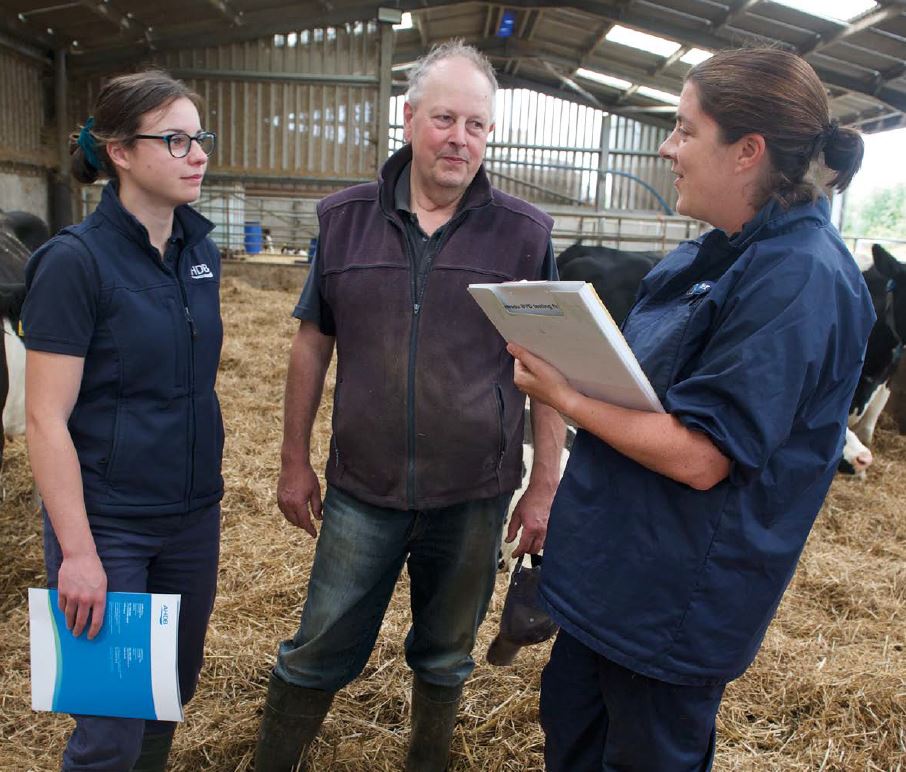Driving herd health improvements on Welsh dairy farms
Tuesday, 7 March 2023
HerdAdvance has supported more than 500 Welsh dairy farmers to improve animal health and welfare by adopting pre-emptive herd health planning techniques explains Delyth Lewis-Jones, AHDB Head of Dairy Development Wales.
Herd health is fundamental to the profitability of every dairy farm. Keeping animals in tip-top condition can be complex – from vaccinating the herd to maintaining a stress-free environment. But seeing a herd thrive, whether through increased milk production or healthy youngstock, is one of the most satisfying and rewarding experiences for any farmer.
HerdAdvance set out to help Welsh dairy farmers lift herd profitability and performance by improving disease prevention and control.
From autumn 2018, farmers were given the opportunity to tap into support to improve their awareness of disease control and to also put in place measures that protect herd health and welfare. Support ranged from Johne’s quarterly testing to regular mobility scoring.
Each farm signed up to engage with HerdAdvance for a three-year period. At the outset, they were assigned an AHDB animal health knowledge exchange manager (AHKEM) who worked with the farm on a one-to-one basis for the duration of the three years.
The first visit by the AHKEM involved collating general information about the farming business and system, as well as technical data relating to the herd’s health and welfare.
Following the initial data collection visit, a two-hour funded vet meeting was held where the AHKEM, vet and farmer would discuss the data gathered to get an understanding of the herd’s health and performance.
These meetings would involve updating the farm’s Herd Health Plan and setting out three priority areas for the farmer to focus on. The AHKEM would then develop the priority areas into a Herd Action Plan, with steps for the farmer to follow.
Over the three years, a maximum of four sets of technical data were taken from the farm, from the baseline to Year 3. By repeating the data collection visits annually, the project has been able to track and benchmark performance, allowing analysis of how HerdAdvance interventions have helped businesses to better record data and make positive changes to their herd management.
Figures are now emerging that show how proactive animal health planning is making a difference on participating farms. Data from Year 3 of the five-year programme shows a significant reduction in disease prevalence, especially when it comes to mastitis and lameness incidences on participating farms. These reductions have also resulted in financial benefits for many farms, with improved productivity often resulting in increased profitability.
The number of farmers participating in HerdAdvance has been positive too, with 513 interacting with the project. This means that a third of all dairy farmers in Wales have benefited from involvement.
Depending on the need, farmers were given the opportunity to benefit from a range of funded interventions linked to the designated priority areas. Johne’s quarterly testing and management plans proved to be the most popular, along with disease management through bulk milk testing.
HerdAdvance interventions are likely to have long-term benefits
The payback from the HerdAdvance project is likely to continue for many years. Some improvements were almost immediate, but the impact of some measures, such as on Johne’s disease, will take longer.
Data analysis of all HerdAdvance farms has shown in the first year the average annual yield per cow increased from 7,333 litres to 7,500, while the calving index reduced from 400 days to 398.
While true Johne’s prevalence is slow to change, increased testing and improved awareness of the disease resulted in a 2–3% average increase in cows testing positive by the second HerdAdvance data gathering visit.
On average, by that second visit, milk production increased in these herds from 7,200 to 7,500 litres/cow/year. This could be because of improved detection of Johne’s disease and more proactive culling of low-yielding Johne’s positive cows.
For farms targeting a full economic net margin of 4.8ppl (AHDB 2020), this increase of 300 litres is likely to result in a financial benefit of £14.40 per cow per year.
Following the third data collection visit there was a reduction in the average incidence rate of clinical mastitis reported; a reduction of three cases per 100 cows per year. Applying a cost of £313 to a case of mastitis represents a saving of £939 per 100 cows per year.
A focus on improving foot health yielded a major financial benefit for many farms. The data showed a significant reduction in the average reported incidence of lameness, with the rate down by two cases, from 20 cases per 100 cows to 18. When a cost of £323 per case of lameness is applied, this improvement in foot health represents a saving of £646 per 100 cows per year.
 Debbie James
Debbie James

